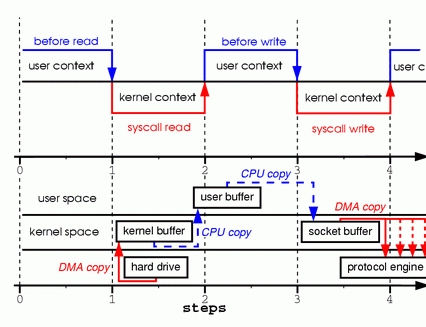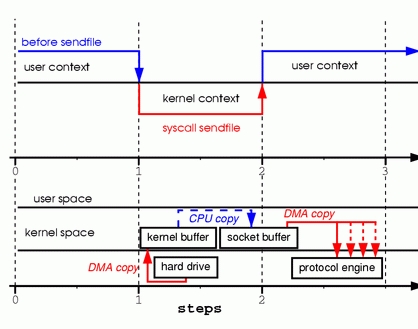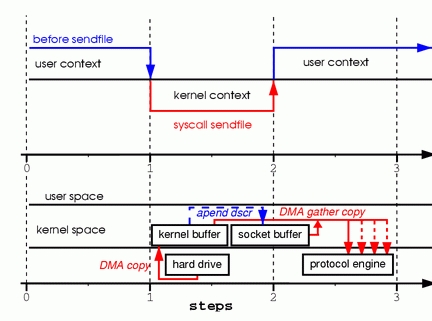Zero-Copy&sendfile浅析
一、典型IO调用的问题
一个典型的web服务器传送静态文件(如CSS,JS,图片等)的过程如下:
read(file, tmp_buf, len);
write(socket, tmp_buf, len);
首先调用read将文件从磁盘读取到tmp_buf,然后调用write将tmp_buf写入到socket,在这过程中会出现四次数据 copy,过程如图1所示

图1
1。当调用read系统调用时,通过DMA(Direct Memory Access)将数据copy到内核模式
2。然后由CPU控制将内核模式数据copy到用户模式下的 buffer中
3。read调用完成后,write调用首先将用户模式下 buffer中的数据copy到内核模式下的socket buffer中
4。最后通过DMA copy将内核模式下的socket buffer中的数据copy到网卡设备中传送。
从上面的过程可以看出,数据白白从内核模式到用户模式走了一 圈,浪费了两次copy,而这两次copy都是CPU copy,即占用CPU资源。
二、Zero-Copy&Sendfile()
Linux 2.1版本内核引入了sendfile函数,用于将文件通过socket传送。
sendfile(socket, file, len);
该函数通过一次系统调用完成了文件的传送,减少了原来 read/write方式的模式切换。此外更是减少了数据的copy,sendfile的详细过程图2所示:

图2
通过sendfile传送文件只需要一次系统调用,当调用 sendfile时:
1。首先通过DMA copy将数据从磁盘读取到kernel buffer中
2。然后通过CPU copy将数据从kernel buffer copy到sokcet buffer中
3。最终通过DMA copy将socket buffer中数据copy到网卡buffer中发送
sendfile与read/write方式相比,少了 一次模式切换一次CPU copy。但是从上述过程中也可以发现从kernel buffer中将数据copy到socket buffer是没必要的。
为此,Linux2.4内核对sendfile做了改进,如图3所示

图3
改进后的处理过程如下:
1。DMA copy将磁盘数据copy到kernel buffer中
2。向socket buffer中追加当前要发送的数据在kernel buffer中的位置和偏移量
3。DMA gather copy根据socket buffer中的位置和偏移量直接将kernel buffer中的数据copy到网卡上。
经过上述过程,数据只经过了2次copy就从磁盘传送出去了。
(可能有人要纠结“不是说Zero-Copy么?怎么还有两次copy啊”,事实上这个Zero copy是针对内核来讲的,数据在内核模式下是Zero-copy的。话说回来,文件本身在瓷盘上要真是完全Zero-copy就能传送,那才见鬼了 呢)。
当前许多高性能http server都引入了sendfile机制,如nginx,lighttpd等。
三、Java NIO中的transferTo()
Java NIO中
FileChannel.transferTo(long position, long count, WriteableByteChannel target)
方法将当前通道中的数据传送到目标通道target中,在支持Zero-Copy的linux系统中,transferTo()的实现依赖于 sendfile()调用。
四、参考文档
《Zero Copy I: User-Mode Perspective》http://www.linuxjournal.com/article/6345?page=0,0
《Efficient data transfer through zero copy》http://www.ibm.com/developerworks/linux/library/j-zerocopy
《The C10K problem》http://www.kegel.com/c10k.html
blog comments powered by Disqus